Motorola Moto G (3rd gen) Review
Why you can trust Tom's Hardware
Camera Performance And Photo Quality
To see how the Moto G’s new rear camera actually performs, we’re comparing its pictures to those taken by several other similarly priced phones. For reference, the Moto E (2nd gen) uses a Samsung S5K5E2 5 MP sensor (the same one the Moto G uses for its front camera). The Asus ZenFone 2 comes with a 13 MP Toshiba sensor and the NUU Z8 uses the same 13 MP Sony IMX214 Exmor RS sensor as the Moto G. We’re also including the much more expensive Samsung Galaxy S6, which has the best performing camera we’ve tested, to serve as a reference.
All of the images shown below were taken with the default camera app using the Auto mode unless noted. Also, you can view the full-sized image for each photo by clicking the text links below the images that are within a slideshow album. All of the phones shoot natively at a 4:3 aspect ratio except for the Galaxy S6, which takes 16:9 pictures.
Outdoors
Daylight



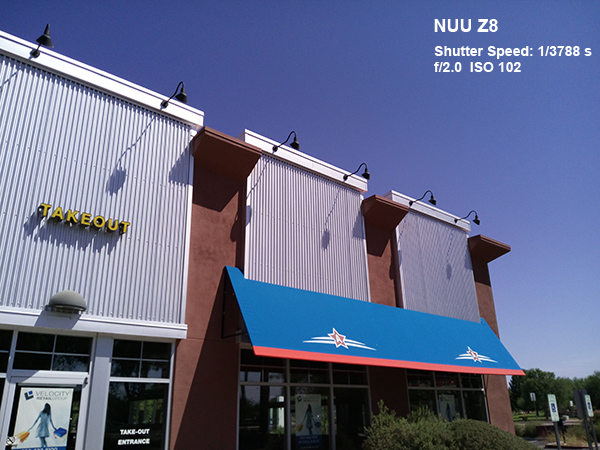


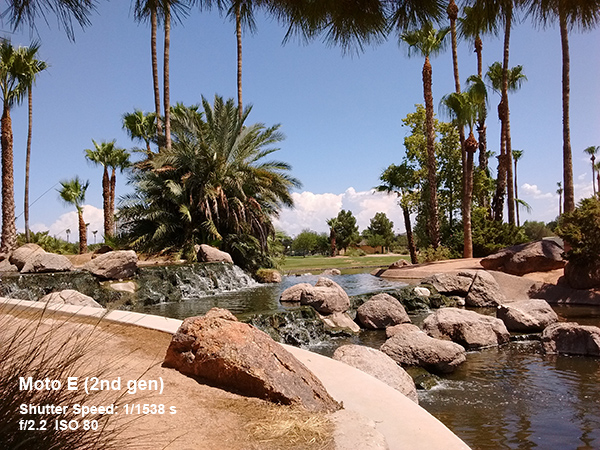



Full-Size Images: [Moto G (3rd gen): daylight restaurant], [Moto E (2nd gen): daylight restaurant], [Asus ZenFone 2: daylight restaurant], [NUU Z8: daylight restaurant], [Galaxy S6: daylight restaurant], [Moto G (3rd gen): daylight waterfall], [Moto E (2nd gen): daylight waterfall], [Asus ZenFone 2: daylight waterfall], [NUU Z8: daylight waterfall], [Galaxy S6: daylight waterfall]
In the first series of images taken outdoors, the photos from the Moto G (3rd gen) show better white balance than those from the Moto E (2nd gen) and the NUU Z8, both of which render the sky more purple than blue and show a reddish tint on the building’s metal siding and the clouds in the sky. The Moto G’s photos have a slight yellow tint, especially the waterfall photo, but its color imbalance is less noticeable. The ZenFone 2 tends to overly saturate colors, which the Moto G avoids.
The restaurant photo captured by the Moto G, Z8, and ZenFone 2 is underexposed and a little dark. However, both of the Moto G’s images show less noise in the sky than the Moto E (2nd gen), Z8, and ZenFone 2. This is partially because of the post-processing the Moto G performs to smooth noise grain. We do see some haloing around the logo on the restaurant awning and words on the white poster in the door as a side effect, though.
Evening
Get Tom's Hardware's best news and in-depth reviews, straight to your inbox.





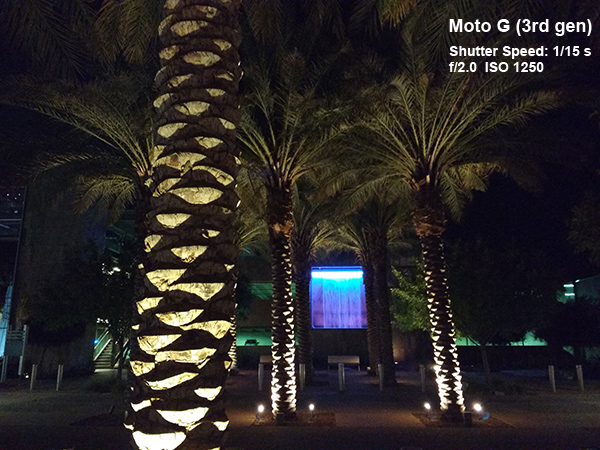
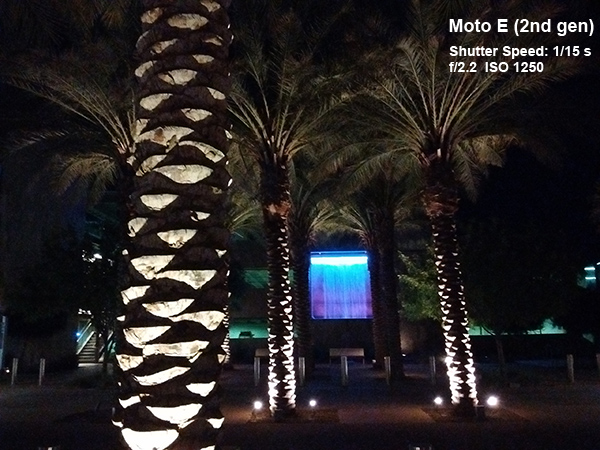
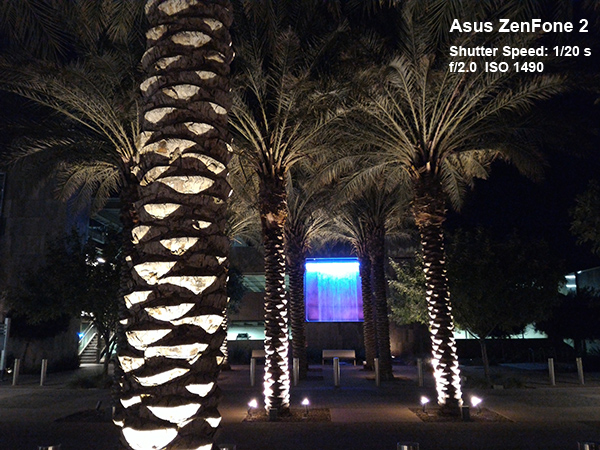

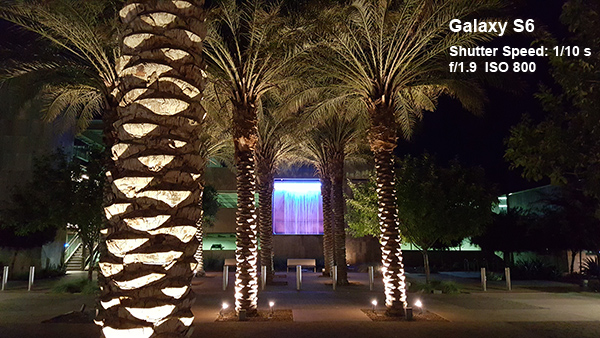
Full-Size Images: [Moto G (3rd gen): dusk posters], [Moto E (2nd gen): dusk posters], [Asus ZenFone 2: dusk posters], [NUU Z8: dusk posters], [Galaxy S6: dusk posters], [Moto G (3rd gen): night waterfall], [Moto E (2nd gen): night waterfall], [Asus ZenFone 2: night waterfall], [NUU Z8: night waterfall], [Galaxy S6: night waterfall]
The pictures of the movie posters were taken at sunset, so the light was more yellow than usual. Both the Galaxy S6 and the Moto G (3rd gen) produce images with nice looking colors, while the Moto E (2nd gen) and Z8 struggle with white balance here. The ZenFone 2 gets the white balance close, but underexposes the photo and creates the darkest image of the group.
Once again the Moto G keeps noise to a minimum, but its noise reduction algorithm smooths away much of the detail on the wall. The ZenFone 2 image is significantly noisier and the Moto E’s lower resolution camera captures much less detail. While the Galaxy S6 produces the best image, the Moto G (3rd gen) is the best of the rest.
While mid-range phones are capable of taking decent images in bright sunlight, it’s really in low-light or dark environments where they really fall behind the more expensive devices like the Galaxy S6, which uses its larger aperture lens and a longer exposure, thanks to optical image stabilization, to capture more light in this night scene. Without OIS, the Moto G (3rd gen), along with the other phones in this test, must use a faster shutter speed to minimize blur and compensate with higher ISO, leading to more image noise while still failing to match the brightness of the image from the Galaxy S6.
The Moto G’s image shows less noise and more shadow detail than the Moto E, but it picks up an ugly green tint. The ZenFone 2 performs better than the Moto G in this very dark scenario, producing a brighter image with better color. You can also see more detail in the ZenFone 2 image like the bricks on the ground that the Moto G’s noise reduction smears away.
HDR












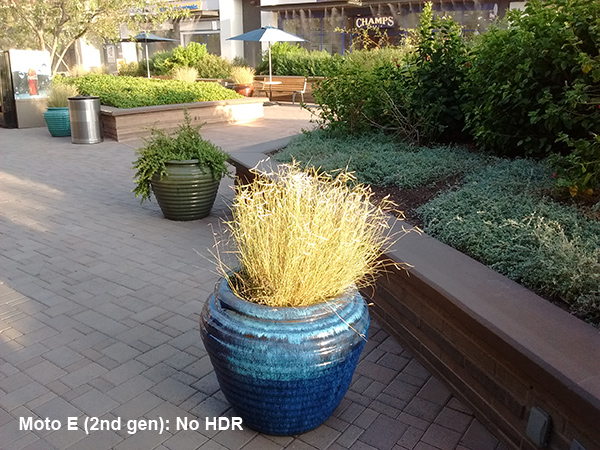







Full-Size Images: [Moto G (3rd gen): pond - no HDR], [Moto G (3rd gen): pond - HDR], [Moto E (2nd gen): pond - no HDR], [Moto E (2nd gen): pond - HDR], [Asus ZenFone 2: pond - no HDR], [Asus ZenFone 2: pond - HDR], [NUU Z8: pond - no HDR], [NUU Z8: pond - HDR], [Galaxy S6: pond - no HDR], [Galaxy S6: pond - HDR], [Moto G (3rd gen): courtyard - no HDR], [Moto G (3rd gen): courtyard - HDR], [Moto E (2nd gen): courtyard - no HDR], [Moto E (2nd gen): courtyard - HDR], [Asus ZenFone 2: courtyard - no HDR], [Asus ZenFone 2: courtyard - HDR], [NUU Z8: courtyard - no HDR], [NUU Z8: courtyard - HDR], [Galaxy S6: courtyard - no HDR], [Galaxy S6: courtyard - HDR]
Motorola’s High Dynamic Range (HDR) algorithm is more aggressive than the one Samsung uses for the Galaxy S6, resulting in brighter, less-natural looking images. However, both the Moto G (3rd gen) and Moto E (2nd gen), which appear to use the same algorithm, avoid many of the common side effects of HDR post-processing. We do not see a significant loss of detail or purple fringing along sharp edges, for instance, and Motorola’s HDR mode does not desaturate colors like we see in the NUU Z8’s HDR image. The Z8 also appears to apply a sharpening filter after the HDR process that amplifies image noise in the sky, which the Moto G and Moto E avoid.
Motorola’s phones fall short of HDR perfection, however, since both the Moto G and Moto E suffer from an anomaly that darkens the sky above the trees. The light, but not overexposed, sky surrounded by the dark trees seems to trick the HDR algorithm into darkening the sky.
In the second set of HDR images taken just before sunset, the Galaxy S6 handles the shadows in the foreground well but lightens the already bright areas too, including the glare on the umbrella and the reflection from the store windows. Both of Motorola’s phones tend to over-brighten the foreground a little, but they handle the brighter areas in the background better than the Galaxy S6, actually reducing the glare on the vending machine and umbrella.
Like the Moto G, the Z8’s HDR is a bit aggressive, but it makes both the foreground and background too bright. The Z8’s white balance is also a bit too cool. The ZenFone 2’s HDR image is similar to the two Moto phones, but it shows more noise in the background than the Moto G.
Overall, Motorola’s HDR processing performs pretty well, giving the Moto G (3rd gen) the advantage over the NUU Z8 and ZenFone 2.
Indoors
The staged indoor shots below were lit by overhead LED lights, a CFL lamp from the front, and an incandescent overhead light in the background.
Bright Light







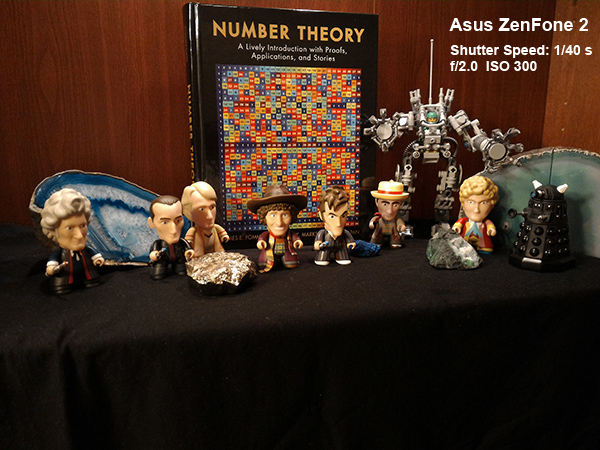


Full-Size Images: [Moto G (3rd gen): indoor bookshelf], [Moto E (2nd gen): indoor bookshelf], [Asus ZenFone 2: indoor bookshelf], [NUU Z8: indoor bookshelf], [Galaxy S6: indoor bookshelf], [Moto G (3rd gen): indoor bright], [Moto E (2nd gen): indoor bright], [Asus ZenFone 2: indoor bright], [NUU Z8: indoor bright], [Galaxy S6: indoor bright]
The first indoor scene with the bookshelf is lit by fluorescent lights, which generally emit light with a strong greenish-yellow component. This skews the white point for both the Galaxy S6 and Moto G (3rd gen). The Moto E (2nd gen) shows even worse color, with the whole image showing an obvious red tint. The image with the most accurate white point actually comes from the ZenFone 2.
Image noise is similar across both sets of photos, with the Moto G doing better than the Moto E and ZenFone 2, but showing more noise than the Z8 and Galaxy S6.
In the second set of photos, most of the cameras struggle with white balance. The Moto G once again looks a little too yellow, while the Moto E and Z8 are a little too red. The ZenFone 2 manages to get the white balance correct in this scenario, but its camera is the only one that underexposes the photo.
Low Light and Flash







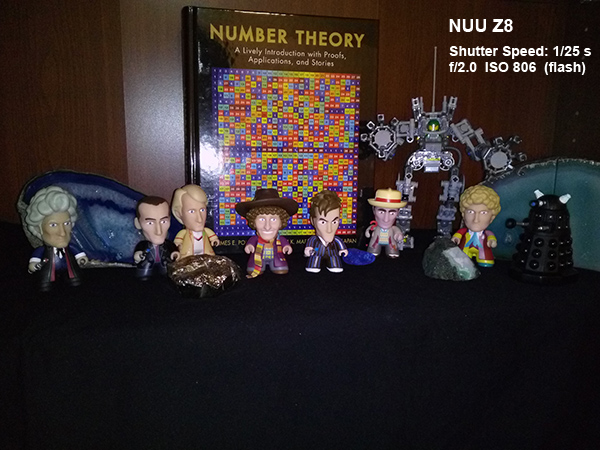

Full-Size Images: [Moto G (3rd gen): indoor dark], [Moto E (2nd gen): indoor dark], [Asus ZenFone 2: indoor dark], [NUU Z8: indoor dark], [Galaxy S6: indoor dark], [Moto G (3rd gen): indoor flash], [Asus ZenFone 2: indoor flash], [NUU Z8: indoor flash], [Galaxy S6: indoor flash]
In low light we see the more expensive Galaxy S6 pull ahead of the pack again. At the other end of the scale in both price and performance is the Moto E (2nd gen). It produces a very dark and noisy image with a heavy red tint.
The Moto G (3rd gen) sits right in the middle. Its image is also dark but is still brighter than the ZenFone 2’s image. Colors look good and image noise is similar to the ZenFone 2 but better than the Moto E and the Z8, which uses a much higher ISO. The Moto G also avoids the noise reduction artifacts seen in the Z8’s image, where faces show yellow splotches.
The Moto G and Galaxy S6 images show similar brightness when using the flash, but the Moto G needs a much higher ISO increasing noise. Both the Z8 and ZenFone 2 set the wrong white point and the Moto E does not have a flash. The Moto G ends up with the second best image of the group when using its flash.
Front-Facing Camera


Full-Size Images: [Moto G (3rd gen): front camera indoors], [Moto G (3rd gen): front camera outdoors]
The first picture using the front camera was taken indoors with natural lighting. Despite the pale yellow wall for a backdrop, the Moto G’s new front camera gets the white balance correct. There’s sufficient detail to make out the pattern on the shirt, and while there is some noise, it’s not too bad.
The other picture was taken in bright sunlight outdoors. Again we see another good picture with accurate, nicely-saturated colors. The front camera also gets the exposure right, managing to avoid overexposing the highlights on the face and clouds in the sky.
After shooting a bunch of photos and comparing some of them to those taken by a few of its peers, the Moto G (3rd gen) ends up having one of the best cameras in its price range. It manages to outperform the NUU Z8 and ZenFone 2 in almost all of the scenarios shown above and is a significant step up from the camera in the Moto E (2nd gen), as expected.
The Moto G performs its best in bright conditions or when using its flash. In these conditions, image noise is low but there’s a noticeable loss of detail from the noise reduction processing. Color accuracy is pretty good, although white balance skews towards yellow frequently.
In lower-light scenarios, the Moto G, like its peers, struggles to capture enough light and image noise becomes more of a problem. Its performance ends up being about average for phones with 13 MP cameras.
Lucian Armasu is a Contributing Writer for Tom's Hardware US. He covers software news and the issues surrounding privacy and security.
-
MasterWandu Just got the 16GB phone. Best value for money phone I have ever owned. Cannot believe the quality / specs at the price point. It's about as quick / specc'ed as my Nexus 4 that it replaces, but it trumps the Nexus 4 with it's expandable memory and 4G/LTE capabilities. Couldn't recommend it more!Reply -
gangrel I don't game on my phone, so that's never been an issue for me. I do note that app install speeds are very good; download speed I can't really say, as I do all of that on wifi, not cell. I'm quite happy with it.Reply -
Glock24 Why is the ZenFone 2 listed in the specs / comparison table , but not on benchmarks? It's $20 cheaper than the Moto G 16GB/2GBReply -
MattBoothDev Only issue is it released a couple of months ago, but isn't getting Marshmallow. Bit poor, that.Reply -
RCFProd Reply16943558 said:Only issue is it released a couple of months ago, but isn't getting Marshmallow. Bit poor, that.
it is getting Marshmallow no?
http://www.androidstandard.com/android-m-will-hit-moto-g-3rd-gen-and-2nd-gen-in-this-fall/ -
ZolaIII Not impressed. There are similar spec Chinese phone's with more than 2x lower price like for instance Elephane Trunk. I know it's weird Elephone made a decent phone but strange things happen. As much as Motorola got a developer community and long suport it's not worth 2+x.Reply -
MobileEditor ReplyWhy is the ZenFone 2 listed in the specs / comparison table , but not on benchmarks? It's $20 cheaper than the Moto G 16GB/2GB
There are two different versions of the ZenFone 2 (well more if you count the special editions). The less expensive version is shown in the spec table since it's closer in price to the Moto G. We only tested the more expensive version with a faster SoC, so that's why it's not in the benchmark charts. Plus, we already included the more expensive/faster Z8 as the upper bound in the charts. I figured this was more relevant, since it has a more common SoC configuration.
- Matt Humrick, Mobile Editor, Tom's Hardware